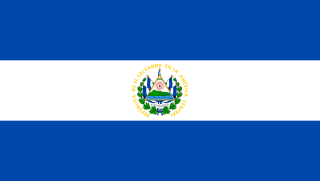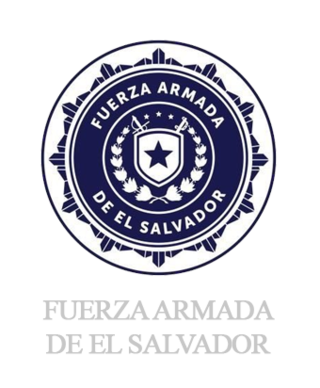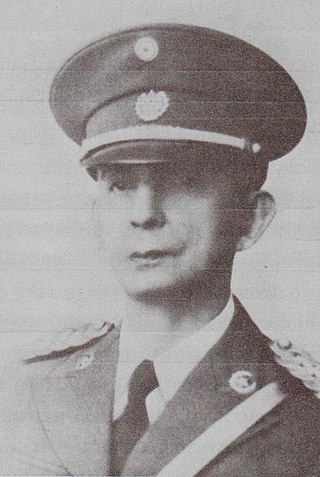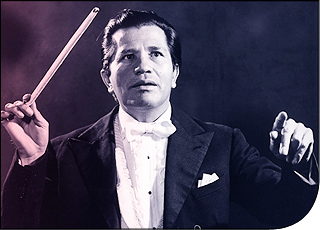| |||||
| Decades: | |||||
|---|---|---|---|---|---|
| See also: | |||||
The following lists events that happened in 1922 in El Salvador .
| |||||
| Decades: | |||||
|---|---|---|---|---|---|
| See also: | |||||
The following lists events that happened in 1922 in El Salvador .

El Salvador, officially the Republic of El Salvador, is a country in Central America. It is bordered on the northeast by Honduras, on the northwest by Guatemala, and on the south by the Pacific Ocean. El Salvador's capital and largest city is San Salvador. The country's population in 2023 was estimated to be 6.5 million.

The Armed Forces of El Salvador are the official governmental military forces of El Salvador. The Forces have three branches: the Salvadoran Army, the Salvadoran Air Force and the Navy of El Salvador.
The Football War, also known as the Hundred Hours' War or 100 Hour War, was a brief military conflict fought between El Salvador and Honduras in 1969. Existing tensions between the two countries coincided with rioting during a 1970 FIFA World Cup qualifier. The war began on 14 July 1969 when the Salvadoran military launched an attack against Honduras. The Organization of American States (OAS) negotiated a cease-fire on the night of 18 July, which took full effect on 20 July. Salvadoran troops were withdrawn in early August.

Rafael Antonio Gutiérrez was the president of El Salvador from 10 June 1894 to 13 November 1898. He was a leader of the Revolution of the 44 which overthrew President General Carlos Ezeta from April to June 1894. He served as provisional president until being officially inaugurated in March 1895 after his victory in the 1895 presidential election, in which he was the only candidate.

Osmín Aguirre y Salinas was a Salvadoran military officer and politician who served as the provisional president of El Salvador from 21 October 1944 until 1 March 1945. A Colonel in the Salvadoran Army, Aguirre y Salinas led two successful coups against the Salvadoran government: once in 1931 and again in 1944. He left office in 1945, with the assurance that his successor in the next election would be Salvador Castaneda Castro. He was later assassinated near his home in San Salvador at the age of 87.

The municipalities or municipios of El Salvador correspond to the second level administrative division in the Republic of El Salvador which divide its departments. El Salvador contains 262 municipalities.

The Salvadoran military dictatorship was the period of time in Salvadoran history where the Salvadoran Armed Forces governed the country for almost 48 years from 2 December 1931 until 15 October 1979. The authoritarian military dictatorship limited political rights throughout the country and maintained its governance through rigged and fixed elections.

Esteban Servellón Torres was a Salvadoran musician, composer, and pedagogue. He composed, among other works, a Requiem Mass, a sonata for guitar, and several serenades and quartets.
El Salvador Symphony Orchestra is the national symphony orchestra of El Salvador. Founded in 1922, by Paul Müller, it is one of Central America's oldest orchestras. Originally formed as the Banda de los Supremos Poderes, it was renamed the Orquesta Sinfónica del Ejército, before taking its current name. Esteban Servellón and Humberto Pacas have served as its conductors. The OSES was preceded by two earlier classical music groups, the Philharmonic Society of El Salvador (1875) and the National Orchestral Society (1910). OSES is funded by government and private sources.

The National Party of the Fatherland, usually translated as the National Pro Patria Party or simply the Pro Patria Party, was a far-right political party which was the sole-legal political party in El Salvador from its establishment in 1933 until its dissolution in 1945. The party was founded by President General Maximiliano Hernández Martínez to support his government.
The 1979 Salvadoran coup d’état was a military coup d'état that occurred in El Salvador on 15 October 1979. The coup, led by young military officers, bloodlessly overthrew military President Carlos Humberto Romero and sent him into exile. The National Conciliation Party's firm grasp on power was cut, and in its place, the military established the Revolutionary Government Junta of El Salvador (JRG). The junta was composed of two military officers and three civilians.

The Civic Directory was a military junta which governed El Salvador from 2 to 4 December 1931. The junta was composed of twelve members of the Armed Forces of El Salvador from the army, air force, and National Guard. The directory marked the beginning of the era of military dictatorships in El Salvador which lasted until October 1979 with the 1979 Salvadoran coup d'état and the establishment of the Revolutionary Government Junta, a joint civilian-military government which ruled until 1982.
The following lists events that happened in 1931 in El Salvador.
The following lists events that happened in 1935 in El Salvador.
The following lists events that happened in 1939 in El Salvador.
The following lists events that happened in 1945 in El Salvador.

The Palm Sunday Coup was an attempted military coup d'état in El Salvador which occurred in early-April 1944. The coup was staged by pro-Axis sympathizers in the Salvadoran Army against President General Maximiliano Hernández Martínez.
Anarchism in El Salvador reached its peak during the labour movement of the 1920s, in which anarcho-syndicalists played a leading role. The movement was subsequently suppressed by the military dictatorship before experiencing a resurgence in the 21st century.

The Captain General Gerardo Barrios Military School, abbreviated as the EMCGGB, was a military academy in El Salvador. It was established in 1868 and is named after Captain General Gerardo Barrios who served as President of El Salvador from 1859 to 1863. It was located in Antiguo Cuscatlán, Santa Tecla, La Libertad. It was demolished in June 2022 to make way for the construction of the Estadio Nacional de El Salvador.

From January 1822 to July 1823, the five Central American nations of Costa Rica, El Salvador, Guatemala, Honduras, and Nicaragua were controlled by the First Mexican Empire, and briefly, the Supreme Executive Power. Collectively known as the Captaincy General of Guatemala, each nation was one of the five southernmost provinces of the Mexican Empire. This incorporation of Central America brought Mexico to the height of its territorial extent.